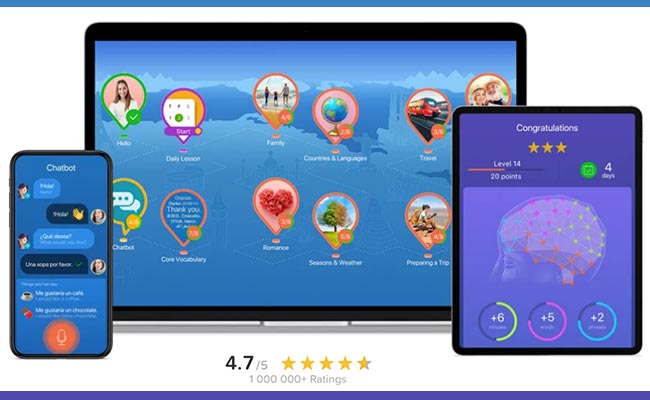Short Overview:
Boasting more than one million reviews on the App Store and Google Play, as well as a massive user base of over 100 million, Mondly stands out as one of the most sought-after language learning apps in the market.
Since its inception in 2014, the app has continuously expanded its offerings and gained significant traction. In 2022, Mondly was acquired by Pearson, a respected education-focused company.
Through the years, Mondly has evolved into a comprehensive language learning platform with diverse products tailored for various audiences, including kids, schools, and businesses.
Mondly is an app designed with beginners in mind. It concentrates on fundamental vocabulary and employs a natural progression to build skills across 41 languages.
Mondly lessons offer a game-like appeal inside a futuristic interface. This approach allows for seamless navigation in and out of lessons, allowing you to pick up where you left off in your next session.
The platform employs images to accompany words and phrases, enhancing visual recall during the learning process. Additionally, the chatbot feature with voice recognition enables users to practice pronunciation effectively.
You can explore the features of the Mondly app without any commitment by trying it for free with a seven-day trial.
During the trial, you'll have access to all premium features. If you prefer not to provide credit card information, you can still enjoy daily free lessons to experience the app's offerings.
+ Click here to try Mondly free
If you want my deeper, more personal insight on this language learning platform, then feel free to read on through my full Mondly review below.
Contents:
How to Use Mondly
You don’t have to sign up for an account to start learning, although it is recommended for data-saving purposes (your learning data, that is).
I thought this was very smart. It can be annoying when all you want to do is quickly try something out, yet you have to go through the whole registration process.
You know the process: you have to wait for an email to arrive in your inbox, and then activate the link in that email, etc.
Once you’re on the website select your native language, and then the language you want to learn and your current level.
Click ‘Start Tutorial' and you’re all set for your first Mondly lesson.
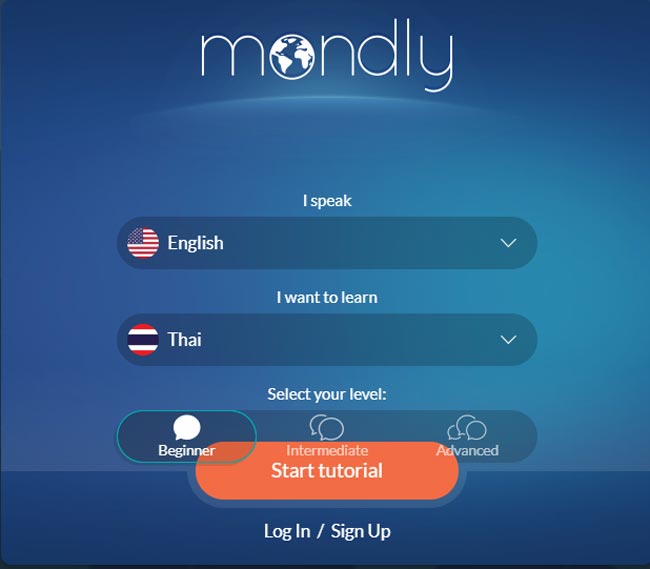
The first tutorial shows on the following screen, which in my case was a common restaurant scene dialogue.
I find the voiceover very authentic, clear and precise. It's obvious that the company has invested well in good voiceover persons to record the dialogue.
In fact, from the UX through to the voicing, there is a mark of quality to Mondly.
Click ‘Continue' to jump to a sample lesson of the vocabulary used in the dialog.
And that's pretty much how Mondly works. It is that simple.
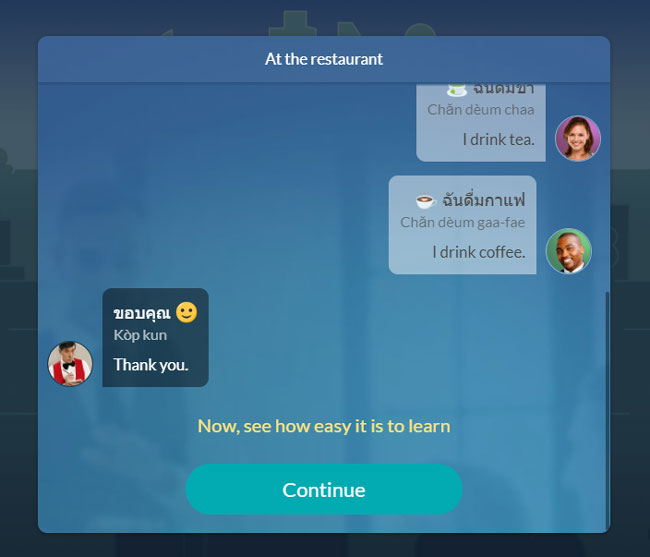
Once done with the tutorial, you will be directed to the ‘home page' where you can see the different learning categories.
There are about 40 categories, each with approximately 8 lessons, which I’ll elaborate on in the next section.
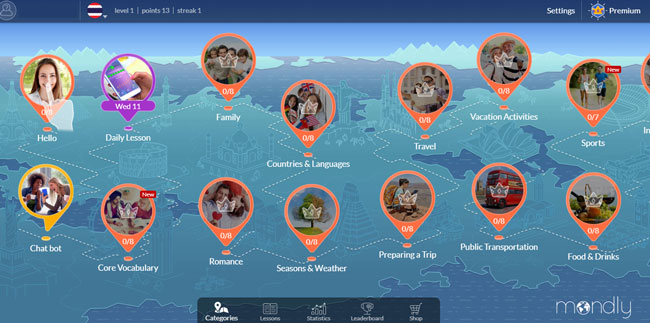
It's worth noting that at present only 3 categories are offered to users on a Free account. The remaining are exclusively for learners with a Premium account.
If you want to upgrade to Premium anytime in your learning journey, just click on any of the locked categories, the ‘Shop' button at the bottom part of the page, or the ‘Premium' button at the top right corner of the screen.
Free users can still learn more than one language: Just click ‘Settings' and then ‘Select Your Language' to add it to your dashboard, as seen below.
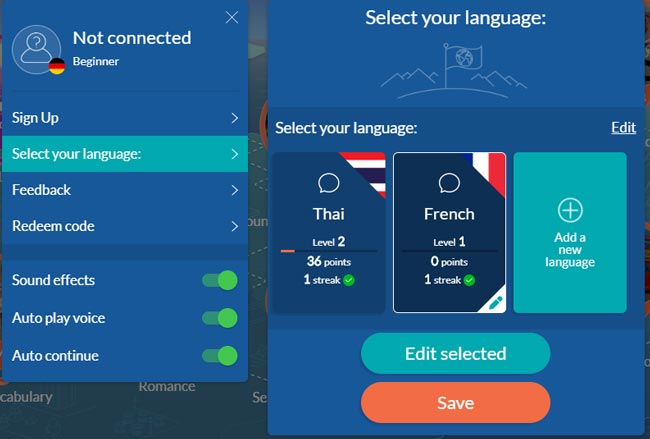
Whether you have two or several languages on your tab, just click on the language you want to learn in the given session, then click ‘Save' to start your lessons.
Lesson Categories
As mentioned, there are over 40 categories, each containing numerous lessons.
The first three categories – Hello, Chatbot, and Daily Lesson – are offered free. The other categories are locked and only Premium users can access them.
Below is a description of 10 the main lesson categories in Mondly.
- Hello: Words, phrases, and sentences used as greetings and for starting a conversation.
- Chatbot: You’ll chat with a chatbot portraying common scenarios in different settings such as a restaurant and hotel. You’ll be presented with replies you can use, and you have the option to use the keyboard for typing, or your microphone if you prefer speaking.
- Daily Lesson: Mondly provides you with daily lessons based on from previously taken lessons to further enhance and test your language retention skills.
- Core Vocabulary: This section presents commonly used words, phrases and sentences; all language you are likely to use on a regular basis.
- Family: Words for, and phrases and sentences relating to, family members and relatives
- Countries and Languages: Words for, and phrases and sentences relating to, different countries and their languages.
- Romance: Words for, and phrases and sentences relating to, romantic relationships such as endearments and affectionate adjectives.
- Seasons and Weather: Words for, and phrases and sentences relating to, seasons, weather, atmosphere and nature.
- Preparing a Trip: Words for, and phrases and sentences relating to, trip preparation, public transportation and essentials like tickets and reservations.
- Travel: Words for, and phrases and sentences relating to, travel such as hotels, airport, public transportation and sightseeing spots.
There's tons more lessons, too, like ‘fun', ‘shopping', ‘eating out' and even ‘parts of the body'.
+ Click here to learn your first language – free
How Mondly Categories Work
Each category provides 6 to 8 core lessons, which include questions about words, phrases and sentences.
Questions are answered in various ways, depending on the type, but the most common is the swipe-up-and-down function.
I enjoy this style because it makes me feel like I'm playing a game rather than studying.
You start with three stars at the top of the screen. If you answer a question incorrectly you'll lose a star!
Below are pictures of the types of questions you'll find in any given category:
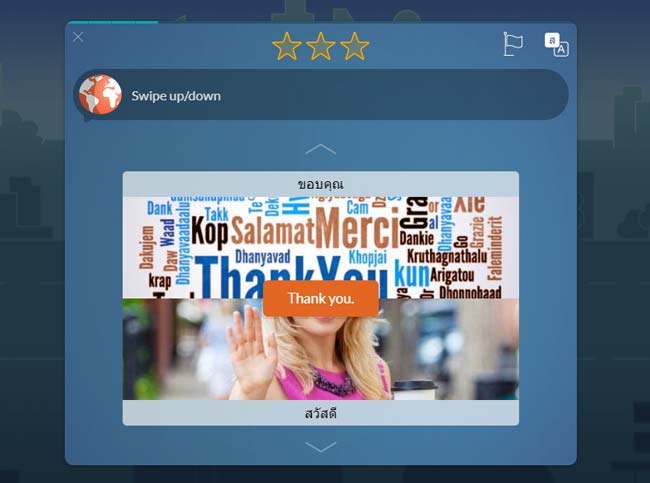
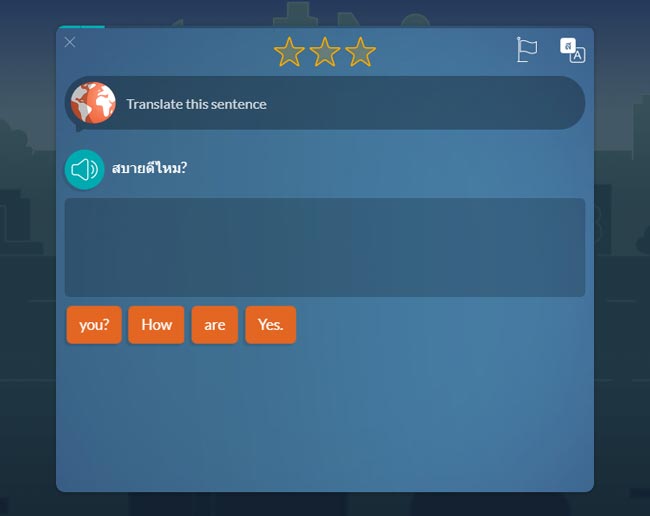
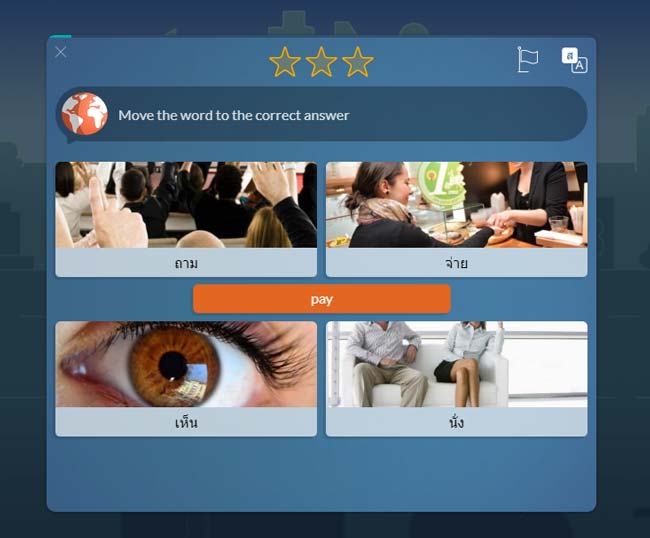
I'm learning a language with a different alphabet (Thai). If you're doing the same, consider the above example.
Even if you don't know the Thai alphabet, the images will help you remember what the word looks like.
Of course, going forward you will have to learn the alphabet of your chosen language. That said, this visual recall technique is really good for remembering everyday words you'll see around town in shops and on public transport.
Conversation & Vocabulary Sessions
Aside from the core lessons, each category also has ‘Conversation' and ‘Vocabulary' sessions.
The ‘Conversation' sessions are the most interactive type of lesson offered by Mondly (at least for me).
It's a dialog between you and the chatbot. The interaction revolves around day-to-day scenarios and is really helpful for enhancing your speaking skills in a native way.
The chatbot speaks to you and you record your reply.
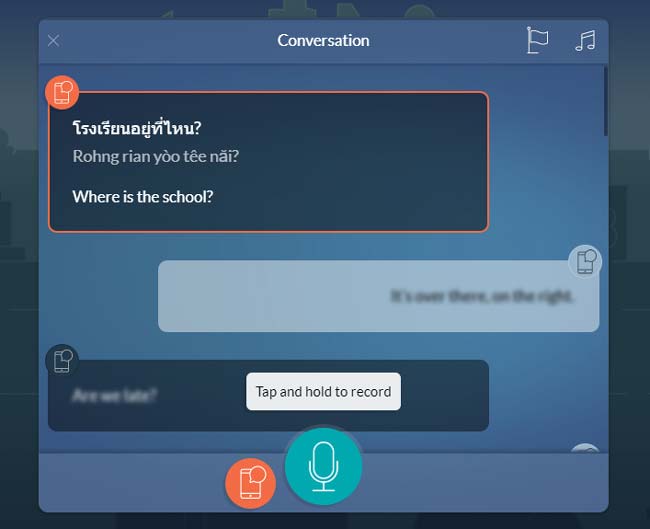
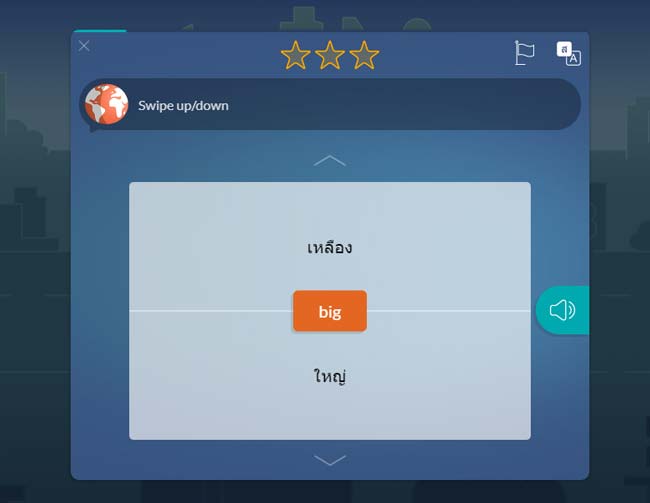
Free vs. Premium Membership
Free:
Mondly's free version offers limited features compared to the premium version.
With the free version, you can only complete one lesson per day, access the first unit of your target language course (six lessons), engage in one chatbot conversation, and explore one vocabulary section. However, you won't have the flexibility to choose topics, difficulty levels, or specific words to learn.
The activities in the free daily lessons closely resemble those in the Mondly premium subscription. Trying a few daily lessons can give you a glimpse of what the full Mondly version offers.
Premium:
Mondly Premium comes with fascinating features. It provides an extensive selection of lessons covering diverse topics such as romance, pets, grammar, banking, and entertainment. Additionally, Premium offers convenient offline mode and a hands-free option, enabling you to learn on the move.
What makes Mondly truly unique is its specialized courses for various professions, including flight attendants, restaurant staff, hotel receptionists, healthcare professionals, and shop assistants. These professional courses set Mondly apart from other language apps and serve as a valuable selling point, especially for individuals working in these industries.
In the premium version, each Mondly language boasts a rich array of features, including:
- Over 250 lessons catering to beginners and advanced learners alike.
- Constant updates with new and fresh lessons.
- Engaging 33 chatbot conversations, simulating real-life interactions.
- 36 vocabulary-building lessons to expand your language skills.
- Speech recognition technology to refine your pronunciation.
- Conjugation and grammar tables for enhanced fluency.
- Access to the Mondly Kids and Mondly AR apps, adding a fun and interactive dimension to language learning.
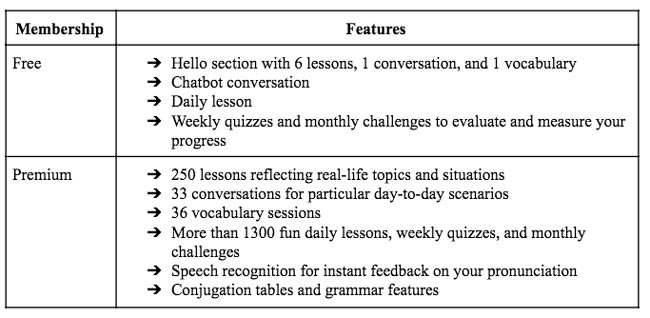
Mondly Pricing
Mondly offers several subscription options to suit your preferences. You can opt for a monthly plan at $9.99, granting access to one language.
Alternatively, a yearly subscription for a single language costs $47.99, or you can enjoy unlimited access to all 41 languages with a lifetime subscription for $89.99. The longer the duration of your subscription, the more cost-effective it becomes in the long run.
As a premium subscriber, you have the added benefit of accessing discounts when multiple users join Mondly. With one additional account, the cost is $15.99/month (27% off). For three additional accounts, the price is $27.99/month (37% off), and for 5 or more accounts, it's $35.99/month (48% off).
+ Start with a FREE membership
Monitoring Your Learning Progress
The Statistics section, which can be found at the bottom part of the Home page, shows several details relating to your progress.
- Points: This shows how many points you’ve accumulated since day 1, lesson 1.
- Streak: This pertains to the number of days you have been taking lessons.
- Level: This is your level of learning based on the lessons you’ve taken and your score.
- Brain: One of the coolest features of Mondly, the image of the brain shows neural connections related to your lessons. Tap or click on the connections to review content. Below the brain, you can also find the number of words and phrases you have learned, and the time taken for learning.
- Daily Progress Chart: As it implies, this shows your progress in the form of a chart, so you can easily see your daily scores and how much you’ve improved.
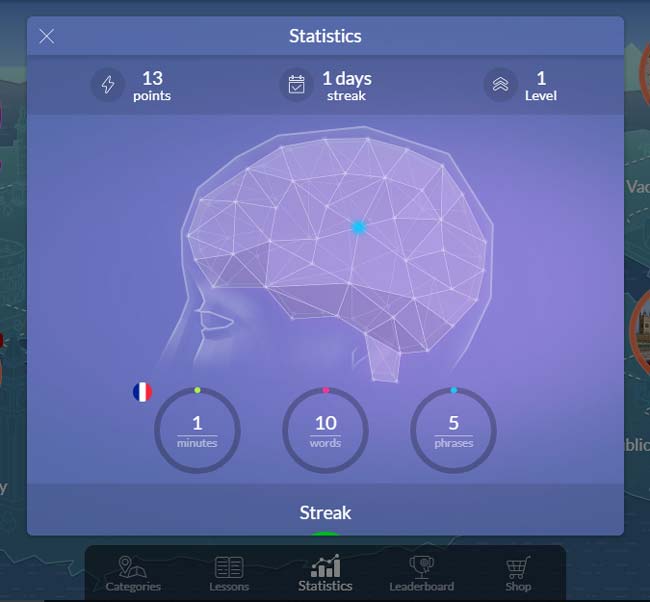
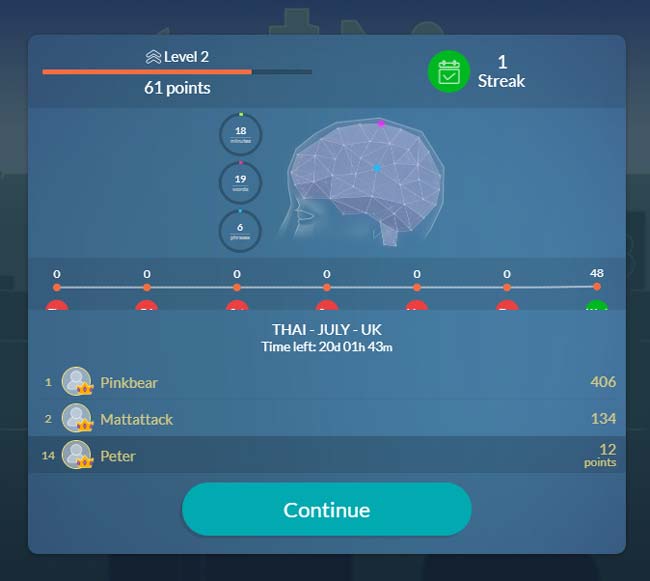
Leaderboard
The leaderboard is where you can see your ranking among other learners of the same language.
It also ranks countries based on the points of all learners, by month or all-time, and ranks the learners based on Streak – the number of consecutive days you've used the app.
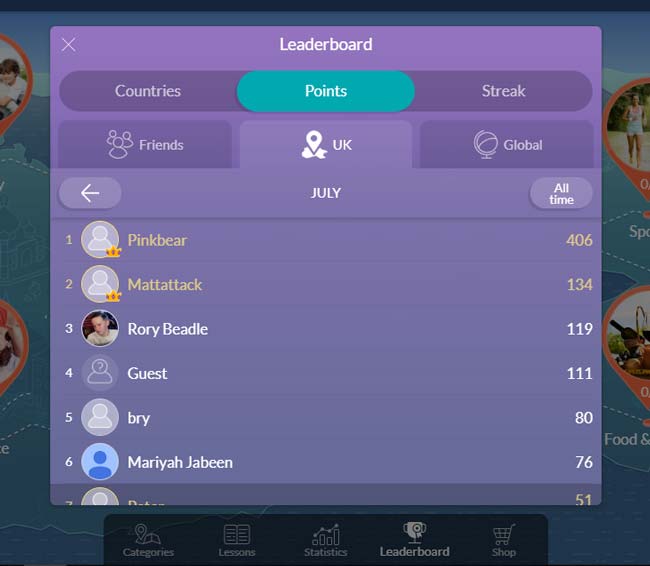
There are 3 units under the tab Points:
- Friends: This feature encourages learning motivation by letting you compete with your friends, family or anyone else who wants to learn the language. This is a cool feature, particularly if you are going traveling with one or more friends.
- Country: Here you'll find your ranking among other learners (in your country) of the same language.
- Global: In this section, you can see how well you rank in comparison to other learners worldwide.
Mondly VR
Mondly breaks new ground as the first popular language app to introduce virtual reality (VR) into language learning! With an immersive experience powered by chatbots and speech recognition, the Mondly VR app can be downloaded via Oculus or Steam, provided you have a VR headset. Currently, 30 out of the 41 languages are available on this platform.
The VR app is designed to complement your learning on the regular app, offering similar topics like ordering dinner in a restaurant or checking into a hotel. While the experience may not be flawless yet, it's a promising innovation that we'll be closely monitoring to witness its growth and improvements in the future.
Mondly AR
As part of the premium subscription, the Mondly AR app introduces augmented reality (AR) technology to the language learning experience, making it a standout feature in the app world. With AR, digital animations are overlaid onto your phone's camera, creating an engaging and interactive learning environment. The best part is that it's user-friendly and doesn't require any tech-savviness to set up.
Currently offering 10 different lessons and three conversation activities, the Mondly AR app is a fun addition to the premium subscription. However, it's still in its early stages and doesn't provide a vast amount of content. While it's a cool feature to explore, it might not be enough on its own to warrant a separate purchase.
Though the app offers all the languages available in the regular Mondly app, its primary focus seems to be on entertainment rather than intense language learning. While it's enjoyable to play around with, the current version may not yield substantial learning outcomes. Nevertheless, the Mondly AR app holds promise for the future, and I'm eager to witness its further development!
Mondly Kids
As part of the premium subscription, Mondly offers the Mondly Kids app, catering to the language learning needs of preschool and school-aged children. It's heartening to see an increasing number of language apps designed for kids, promoting early language education.
The sign-up process for the Mondly Kids app closely mirrors that of the regular Mondly app. You select your original and target languages and choose the appropriate level for your child's learning journey. The beauty of the Mondly Kids app is that it shares the same languages as the other Mondly apps, allowing families to learn together.
The activities and topics in the Mondly Kids app bear a striking resemblance to the regular app, making the learning experience consistent across all Mondly platforms. While the main difference appears to be in the app's design, it remains a valuable addition to the premium subscription.
For those with children, the Mondly Kids app is a wonderful resource for introducing language learning to young minds. However, as a standalone purchase, it might not be a priority for individuals without kids. Nevertheless, it's a delightful feature for families aiming to learn languages together.
Mondly: The Pros & Cons
The Good
1. Great Graphics & Animation
Mondly is very well designed. It utilizes graphics and animation to create a game-like dynamic. In the majority of the core lessons, a visual representation of the word being taught assists in enhancing the learning process. Mondly really understands the importance of visual learning and that some people are wired this way – me being one.
2. Supports Various Languages
Mondly supports not just the most common languages such as Chinese, German, and French, but even the not-so-familiar yet equally interesting ones like Croatian and Farsi, and in my case, Thai.
3. Transliteration & Voice Over
Mondly gives you the option to toggle between the transliteration and the script (or any language you choose). This is very useful for learning Thai or Chinese.
The transliterations match up well with what the speaker is saying, so it is easy to recognize the word on the screen.
This and the visual representation mentioned earlier ultimately make it easier to remember the words.
4. Speaking with a Native
The biggest downside to learning a language using a language learning platform is not having a native speaker to practice with.
Mondly doesn't quite give you that, but what it does give you is a level of interaction with a native speaker via a chatbot.
This virtual reality-type feature creates a real-life scenario, which adds that bit of pressure you need to ensure your language skills translate to real-life situations outside of the learning program.
5. Free Membership
Mondly offers free lessons to everyone. Although this comes with restrictions, it can be a help to those who want to have some fun and learn a few “holiday words”. The free membership never expires.
It's also super-quick to get started. There is no sign up process required to jump in and take a lesson straight away.
Generally speaking there is always a good deal on, either a yearly deal or a lifetime membership deal.
The Not So Good
1. Repetition
The Mondly system is precisely that—a system. You'll encounter the same format across all 41 languages.
Unlike platforms tailored for a specific language, where features are designed around its unique characteristics, the Mondly system uses a templated approach for all languages.
This isn't necessarily a drawback, but if you're learning multiple languages, you might find the format becoming monotonous over time.
Nonetheless, this standardized format has contributed to Mondly's popularity. The repetition is balanced by swift progress. With Mondly, you'll learn rapidly, finding yourself able to use new words immediately.
Personally, I believe this system isn't intended for lengthy study sessions. Instead, it's more suitable for short, focused bursts of learning. I usually spend a maximum of about 15 minutes at a time on Mondly before moving on to other activities.
It's designed for dipping in and out, similar to playing a game on your phone. The purposeful repetition helps you quickly grasp a remarkable number of words and phrases within a short period.
2. Additional Learning (non-romanized languages)
Depending on the language, you may need supplementary learning tools.
In my case, I'm learning Thai, and it's essential to have an understanding of the Thai alphabet to read the words.
Mondly does provide images to help memorize the appearance of words, which is useful. However, to achieve proficiency in the language, you must also learn the individual consonants and vowels. This wouldn't be an issue for languages that use a Romanized alphabet.
If your goal is long-term fluency, it's advisable to use Mondly alongside separate learning of the alphabet (script). This combination will lead you towards a more comprehensive and effective language learning plan.
3. Paid Membership
For you to take advantage of the full features of the platform, you'll need to get premium. The free option is good enough for you to test drive the platform and get a feel, but you'll run out of lessons and hit a wall pretty quickly.
I don't think it's expensive, at least not if you go for the 12-month option. Even on a monthly basis it only costs a couple of Starbuck's coffees. Like most tiered payment options these days, you get a considerable discount for locking in for the long term.
In Summary
Mondly is a fun and user-friendly language learning platform. Getting started is effortless, and you'll quickly learn new words and phrases.
For those seeking an on-the-go learning experience, Mondly excels in this regard. Its design allows for convenient and flexible learning, saving your progress for future sessions.
The interface is well-designed and intuitive, making it accessible to users of all ages.
I highly recommend Mondly for travelers, students, professionals working abroad, and anyone planning to migrate to a different country. It's also an excellent platform for polyglots looking to learn multiple languages or test their proficiency in languages they already know.
If you're a visual learner with a preference for shorter learning sessions, Mondly is a great option. Its app-like approach and repetitive nature cater well to this learning style.
While it may not be a comprehensive single language learning platform, few are. To achieve full language proficiency, it's beneficial to use multiple learning tools and engage in real-world conversations.
For languages like Thai, Mandarin, Japanese, or any non-Romanized alphabet languages, you may need to supplement your learning outside of Mondly to grasp the alphabet fully.
In summary, Mondly boasts excellent design and can become quite addictive. It offers an enjoyable and effective language learning experience.

